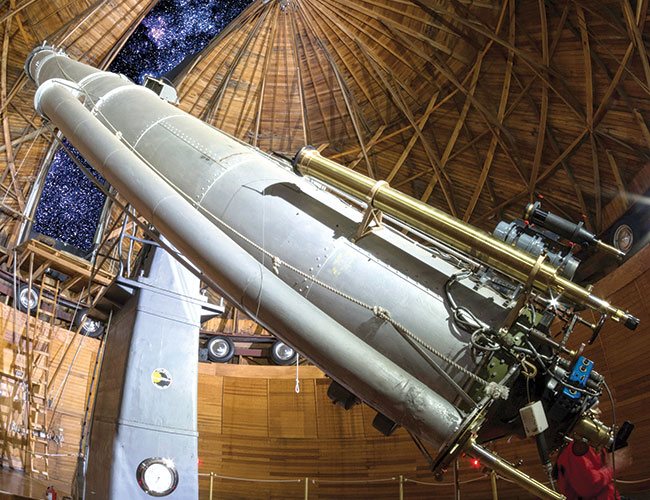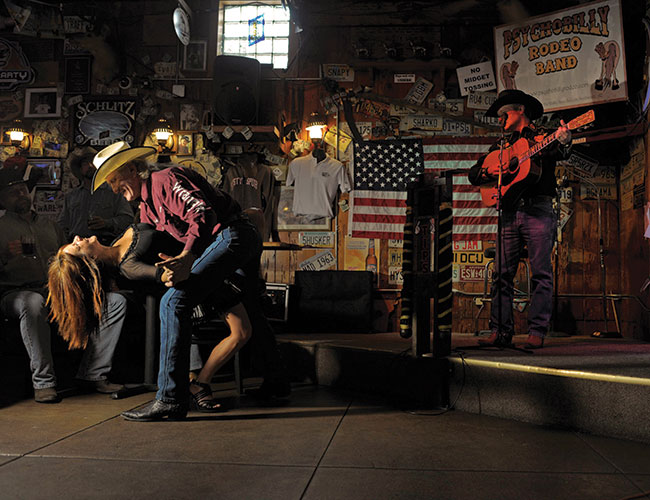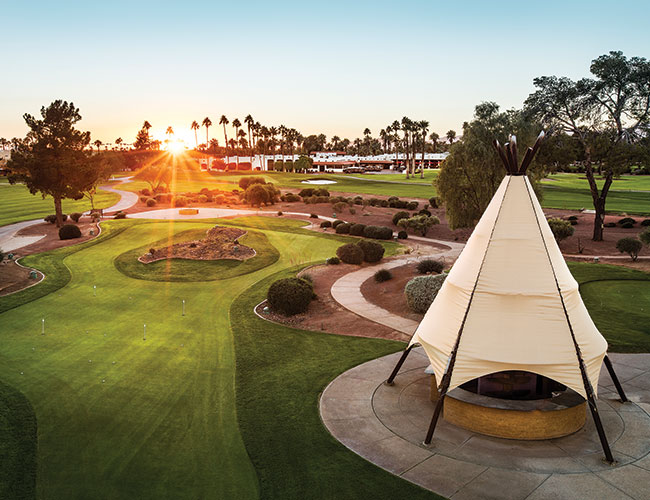In May 2018, the BBC reported on a compelling new discovery in central Arizona’s Verde Valley. Researchers determined that a wall of nearly 1,000-year-old petroglyphs first found in 2004 at the V Bar V Historic Site near Sedona depicted a cosmic calendar for measuring the seasons. The Verde Valley has a dozen such likely calendar sites, with another 30-plus in the Phoenix region.
Statehood only came in 1912, but Arizona, inhabited for 10,000-plus years, has been on the clock since ancient times. For groups, the past and present merge for lasting memories.
Metro Magic
Founded in 1775 as Presidio San Agustin del Tucson, “The Old Pueblo” today offers progressive activities and accommodations against the backdrop of its rich history.
“Tucson maintains a firm grasp on its heritage while offering the modern and innovative amenities you’d anticipate in a city of nearly 1 million people,” said Graeme Hughes, Visit Tucson’s vice president of sales. “Bordered by Saguaro National Park and both Native tribal and National Forest lands, the city sits as the region’s cultural axis. We embrace our Native American, Spanish, Mexican-American and ‘cowboy culture’ roots in a diverse mix of art, architecture and cuisine.”
As Hughes puts it, “complementary forces at work” include group-capable counterparts like the iconic 1930 Arizona Inn and recently opened AC Hotel Tucson Downtown, the district’s first new-build hotel in decades.
Established in 1868 east of Tucson, Tanque Verde Ranch is a working dude ranch offering new luxury glamping tents.
“Stretching the limits of what’s been done keeps Tucson fresh,” Hughes noted. “Another example is Charro del Rey, a new seafood concept from family-owned 1922 downtown landmark El Charro.”
According to Hughes, “downtown Tucson has undergone a radical transformation in the past five years” with the addition of 30-plus new restaurants, clubs, music venues and shops. Slated for 2021, three planned properties from the Moxy, Element and Home2 Suites by Hilton brands will add some 600 new hotel rooms.
Radical, too, is the new Phoenix. Incorporated in 1881, the state capital is truly a city reborn.

Lowell Observatory
“Downtown Phoenix today shows the most progress it has in at least 40 years,” said local historian and former Arizona Republic columnist Jon Talton in a 2018 AZCentral article. “By Phoenix standards, what’s happening in downtown is nothing short of a revolution.”
With some $5.5 billion in downtown improvements since 2005, anchors include the Grand Canyon-inspired Phoenix Convention Center and its interconnected campus that boasts three ballrooms, 99 meeting/breakout rooms, a 2,300-seat performance hall and an executive conference center.
Contemporary downtown spaces include Events on Jackson in the Warehouse District. The 1,800-capacity Van Buren concert venue opened in 2017 in a converted historic vintage auto dealership. Also, the community-driven Churchill offers a 9,000-square-foot event courtyard, and The Duce is the spirited update of a 1928 warehouse.
Chicago confectionary magnate William Wrigley Jr.’s 1931 Wrigley Mansion is a Phoenix landmark for tours and events now operated by the family of Spam-heir George “Geordie” Hormel. Meanwhile, the Heard Museum celebrates Phoenix’s Native American legacy. Founded in 1991, Corona Ranch & Rodeo Grounds hosts 30- to 3,000-capacity events enlivened with cultural programs, including Mexican fiestas and both Mexican or Western rodeo.
Settled in 1888 and incorporated in 1951, Scottsdale’s New West-Old West blend “allows planners to create memorably enriching group experiences,” said Kelli Blubaum, Experience Scottsdale’s vice president of convention sales and services.
Taliesin West master architect Frank Lloyd Wright’s circa-1937 winter home and desert laboratory is a wood and stone wonderland for tours and events. Acclaimed architecture also distinguishes Western Spirit: Scottsdale’s Museum of the West. Opened in 2015, this Smithsonian-affiliated institution hosts 500-capacity events.
Mid-Century Modern charmer Hotel Valley Ho (1956) offers 13,000 square feet of versatile indoor space and 20,000 square feet of outdoor space, including the Sky Line rooftop terrace.

Rusty Spur Saloon, Scottsdale
Other heritage hotels include the circa-1930s Hermosa Inn and 1959 Mountain Shadows, reimagined in 2017. The circa-1936 JW Marriott Camelback Inn Resort & Spa, which later become Marriott’s first resort in 1967, features the new 15,000-square-foot Paradise Ballroom, which includes 16,500 square feet of scenic outdoor terraces.
Shadowed by Camelback Mountain, the 40-acre Scottsdale Plaza Resort, a landmark draw since 1976, has completed a comprehensive three-year, $15 million renovation. Highlights include all 404 guest rooms and revamped indoor and outdoor meeting space, now totaling 50,000 square feet with 21 meeting rooms and a 10,000-square-foot ballroom. The investment also covered its lobby, restaurants, market and spa, plus upgraded Wi-Fi and new landscaping.
“We’re excited about our redesign,” said President Dave Lunt. “Providing comfort, relaxation and functionality while inspiring collaboration and creativity, it’s the quintessential Scottsdale experience for groups.”
Originated in 1934 as a school for girls, Paradise Valley icon El Chorro is Arizona’s first LEED Gold-certified restaurant and a classic choice for outdoor dining and private events. The landmark Rusty Spur is Scottsdale’s last real cowboy saloon, while Blue Clover Distillery is a heritage-inspired micro-distiller of small-batch spirits.
Epic Endeavors
From ancient wonders like the Grand Canyon and the Red Rocks of Sedona to engineering marvels like the Hoover Dam, cross-Atlantic relocation of the London Bridge and Lake Havasu City, Arizona is synonymous with larger-than-life achievements.
That includes staging the groundwork for travel to the moon.
In the 1960s, Flagstaff was ground zero for the U.S. space program. All 12 astronauts who walked on the moon, including Neil Armstrong, whose “giant leap for mankind” in July 1969 is being celebrated this year, trained throughout the area. Scientists at the storied tour-capable Lowell Observatory, minutes from downtown, mapped out the moon landings and discovered Pluto. Meteor Crater and Sunset Crater Volcano National Park, an hour away, served as lunar-like test surfaces. The Museum of Northern Arizona and downtown’s 1911 Orpheum Theater are also part of the 50th anniversary commemorations.
Flagstaff, named after the American flag raised on a pine tree by Boston emigrants passing through the area on July 4, 1876, has vintage gems such as downtown’s Weatherford Hotel (1900) and Route 66 heirloom Motel Du Beau (1929). Little America Hotel (1952) is a AAA Four Diamond hideaway set amid 500 acres of ponderosa pine. Modern facilities include High Country Conference Center and downtown’s Residence Inn by Marriott.
East of Phoenix in dynamic Mesa, Cider Corps, available for group buyouts, is Arizona’s first cidery, located in an updated 1800s-era building. Scheduled for spring 2019, the Bungalow transforms a late 1940s Craftsman-style bungalow into event space. Incorporating an 1890s territorial jail, the event-capable Arizona Museum of Natural History features a dinosaur collection. Also for groups, the $95 million Mesa Arts Center is one of the Southwest’s premier performing and visual arts destinations.
Set along the Colorado River three hours west of Phoenix, sunny Yuma counts the 1876 Yuma Territorial Prison State Historic Park among its event-capable heritage venues.
Modern venues include the Pivot Point Conference Center, with the adjoining Hilton Garden Inn and Suites and 21,500 square feet of space. The Yuma Civic Center offers 25,000 square feet of exhibit space and 15 meeting rooms, with 12,000 square feet of space at Arizona Western College’s Schoening Conference Center. The Yuma Art Center rents its 643-seat theater and four galleries.
Arizona CVB Information
Experience Scottsdale
480.421.100
Flagstaff CVB
928.213.2951
Lake Havasu City CVB
928.453.3444
Sedona COC & Tourism Bureau
928.204.1123
Tempe Tourism
480.894.8158
Visit Mesa
480.827.4700
Visit Phoenix
602.254.6500
Visit Tucson
520.624.1817
Yuma Visitors Bureau
928.376.0100
Click over to page 2 and read about one of Arizona's Historic Gathering places
PageBreakThe Wigwam: Arizona’s Historic Gathering Place
In 1918, the Ohio-based Goodyear Tire & Rubber Company purchased 16,000 acres of ranchland in Phoenix’s West Valley to grow cotton for tire production. Built that year, the Organization House served as lodging for suppliers and Goodyear executives. Its popularity inspired transformation of the farm into a guest ranch, opened as The Wigwam on Thanksgiving Day 1929.
Today, with part of the original Organization House serving as the Fireplace Lounge, the much-expanded Wigwam (“gathering place”) celebrates 90 years of rare distinction. Its Goodyear legacy includes vitally supplying tires and cotton during both World Wars and integrating with Luke Airforce Base operations during WWII.
Spanning 440 acres, the 331-room resort offers 30,000 square feet of indoor space and 55,000 square feet of outdoor space. Venues include the 800-capacity Wigwam Ballroom and 1,000-capacity Wigwam Lawn and Patio. Amenities include award-winning dining, three championship golf courses, nine tennis courts, three swimming pools, a luxurious spa and 29 fireplaces and fire pits.

Tee Pee Putting Green | Credit: The Wigwam
“We invite groups to ‘make history’ with various anniversary offers,” said Marti Trieschmann, regional vice president of sales and marketing. “These include the 90 Years in the Making Package, a competitive commissions program for planners. Other centennial programs include 1929-era cocktails and movies, and our own speakeasy. We also provide regular historical tours and guest speakers for meeting attendees.”
The Wigwam’s enduring appeal is a magnet for repeat business. Extended through 2024, the Interclub Challenge, a 54-hole Pro-Am golf event, has booked the resort every January since 1989.
Another happy customer is Diane McCool, event and conference specialist with Maryland-based T2S Solutions.
“We facilitated the December 2018 meeting of the Organization of Scientific Area Committees for Forensic Science,” McCool said. “We chose The Wigwam for its tremendous overall value, which combined with its storied history and temperate climate proved the ideal location for our December conference. All was flawless, and I would not hesitate to book my next Phoenix-area event at The Wigwam.”






